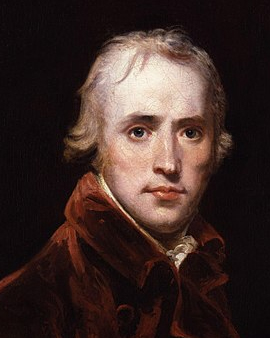Especially his sense of colour and a good eye for contours made the British artist John Hoppner one of the most popular portrait painters of his time. As the son of a German-born chambermaid of Queen Charlotte, he grew up directly at the English royal court. His great interest in art and above all in painting did not remain hidden even from King George III, who was in office at the time and who subsequently supported him and enabled him to study at the Royal Academy of Arts. This unusual career opened several doors for John Hoppner and later helped him to be allowed to paint portraits of the leading heads of England. However, before he caused a furore as a portrait painter of the higher English society, he had devoted himself to landscape painting, which he soon put on the back burner in favour of the more lucrative and prestigious portrait painting.
Due to his highly regarded achievements, he received several awards from the Royal Academy of Arts and was subsequently given the opportunity to exhibit his work in its rooms. He made intensive use of this opportunity and presented about 160 different paintings in the academy until his death in 1810. Subsequently, John Hoppner was also increasingly called upon to create portraits of the royal family, which is why he soon succeeded the famous Joshua Reynolds as official court painter. Although he held this exposed position, he was in a kind of rivalry with the equally popular portrait painter Sir Thomas Lawrence throughout his life.
His influence at the royal court was, however, quite great because of his very coherent portraits, which often depicted the sitters in a very advantageous way. This is illustrated, for example, by the fact that he was able to continue to perform his duties at court despite criticism from his mother-in-law, the American sculptor Patience Wright, about the role of the English in the American War of Independence.
Stylistically, John Hoppner's works impress with strong influences of the Venetian Renaissance and a very good understanding of anatomy, making his works very realistic and lifelike. He preferred to paint with oil colors on canvas, but also understood the art of lithography and engraving.
Of his numerous portraits, which depict not only members of the royal family but also famous personalities of the time, such as Lord Nelson and Joseph Haydn, the portraits of women and children are particularly noteworthy, as they are very detailed and lively. In accordance with the taste of his time, he mostly depicted his models in noble and representative poses. What is special about his painting, however, is the fact that he always placed the charisma of the persons portrayed in the foreground, which gives his works a very special character. His artistic talent has also been passed on to his son Richard Belgrave Hoppner, who was a highly regarded painter of maritime motifs.
×





.jpg)
.jpg)
.jpg)
.jpg)
.jpg)
.jpg)
_as_Perdita_-_(MeisterDrucke-95263).jpg)
_as_Perdita_-_(MeisterDrucke-95263).jpg)
.jpg)
.jpg)
.jpg)
.jpg)
.jpg)
.jpg)
.jpg)
.jpg)
_19th_century_Paris_Mu_-_(MeisterDrucke-1030340).jpg)
_19th_century_Paris_Mu_-_(MeisterDrucke-1030340).jpg)
.jpg)
.jpg)
.jpg)
.jpg)
_later_Lady_Byron_c1800_(oil_on_ca_-_(MeisterDrucke-1520304).jpg)
_later_Lady_Byron_c1800_(oil_on_ca_-_(MeisterDrucke-1520304).jpg)
.jpg)
.jpg)
_Lord_Lynedoch_-_(MeisterDrucke-82090).jpg)
_Lord_Lynedoch_-_(MeisterDrucke-82090).jpg)
.jpg)
.jpg)
_-_(MeisterDrucke-222040).jpg)
_-_(MeisterDrucke-222040).jpg)
.jpg)
.jpg)
_Regiment_of_Foot_-_(MeisterDrucke-1432453).jpg)
_Regiment_of_Foot_-_(MeisterDrucke-1432453).jpg)
.jpg)
.jpg)
.jpg)
.jpg)
_from_National_Portrait_Ga_-_(MeisterDrucke-92994).jpg)
_from_National_Portrait_Ga_-_(MeisterDrucke-92994).jpg)
.jpg)
.jpg)
.jpg)
.jpg)
.jpg)
.jpg)
.jpg)
.jpg)
_-_(MeisterDrucke-114603).jpg)
_-_(MeisterDrucke-114603).jpg)
.jpg)
.jpg)
_-_(MeisterDrucke-1362723).jpg)
_-_(MeisterDrucke-1362723).jpg)
_-_(MeisterDrucke-102708).jpg)
_-_(MeisterDrucke-102708).jpg)
.jpg)
.jpg)
_-_(MeisterDrucke-1454471).jpg)
_-_(MeisterDrucke-1454471).jpg)
.jpg)
.jpg)
.jpg)
.jpg)
_-_(MeisterDrucke-1376931).jpg)
_-_(MeisterDrucke-1376931).jpg)
.jpg)
.jpg)
.jpg)
.jpg)
.jpg)
.jpg)
.jpg)
.jpg)
.jpg)
.jpg)
.jpg)
.jpg)
_-_(MeisterDrucke-1454707).jpg)
_-_(MeisterDrucke-1454707).jpg)
.jpg)
.jpg)
.jpg)
.jpg)
_-_(MeisterDrucke-891483).jpg)
_-_(MeisterDrucke-891483).jpg)
.jpg)
.jpg)
_-_(MeisterDrucke-113056).jpg)
_-_(MeisterDrucke-113056).jpg)
_-_(MeisterDrucke-1360795).jpg)
_-_(MeisterDrucke-1360795).jpg)
.jpg)
.jpg)
.jpg)
.jpg)
.jpg)
.jpg)
.jpg)
.jpg)
.jpg)
.jpg)
.jpg)
.jpg)
_by_John_Hoppner_RA_-_(MeisterDrucke-1574529).jpg)
_by_John_Hoppner_RA_-_(MeisterDrucke-1574529).jpg)
.jpg)
.jpg)
.jpg)
.jpg)
.jpg)
.jpg)
_-_(MeisterDrucke-43041).jpg)
_-_(MeisterDrucke-43041).jpg)
.jpg)
.jpg)
.jpg)
.jpg)
.jpg)
.jpg)
.jpg)
.jpg)
.jpg)
.jpg)
.jpg)
.jpg)
_1800_-_(MeisterDrucke-144785).jpg)
_1800_-_(MeisterDrucke-144785).jpg)
.jpg)
.jpg)
.jpg)
.jpg)
.jpg)
.jpg)
_-_(MeisterDrucke-980487).jpg)
_-_(MeisterDrucke-980487).jpg)
.jpg)
.jpg)
_c1784-1810_(oil_-_(MeisterDrucke-1376390).jpg)
_c1784-1810_(oil_-_(MeisterDrucke-1376390).jpg)
.jpg)
.jpg)
_-_(MeisterDrucke-1377046).jpg)
_-_(MeisterDrucke-1377046).jpg)
.jpg)
.jpg)
.jpg)
.jpg)
.jpg)
.jpg)
.jpg)
.jpg)
.jpg)
.jpg)
.jpg)
.jpg)
.jpg)
.jpg)
_-_(MeisterDrucke-1461661).jpg)
_-_(MeisterDrucke-1461661).jpg)
.jpg)
.jpg)
_Regiment_of_Foot_-_(MeisterDrucke-906429).jpg)
_Regiment_of_Foot_-_(MeisterDrucke-906429).jpg)
.jpg)
.jpg)
.jpg)
.jpg)
_-_(MeisterDrucke-72851).jpg)
_-_(MeisterDrucke-72851).jpg)
.jpg)
.jpg)
.jpg)
.jpg)
_-_(MeisterDrucke-1500044).jpg)
_-_(MeisterDrucke-1500044).jpg)
.jpg)
.jpg)
_-_(MeisterDrucke-1376656).jpg)
_-_(MeisterDrucke-1376656).jpg)
_-_(MeisterDrucke-1453842).jpg)
_-_(MeisterDrucke-1453842).jpg)
 Regiment of Foot c1800 - (MeisterDrucke-15649).jpg)
 Regiment of Foot c1800 - (MeisterDrucke-15649).jpg)
.jpg)
.jpg)
.jpg)
.jpg)
.jpg)
.jpg)
.jpg)
.jpg)
_-_(MeisterDrucke-1450027).jpg)
_-_(MeisterDrucke-1450027).jpg)
.jpg)
.jpg)
.jpg)
.jpg)






